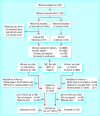Self help smoking cessation in pregnancy: cluster randomised controlled trial
- PMID: 12480850
- PMCID: PMC138509
- DOI: 10.1136/bmj.325.7377.1383
Self help smoking cessation in pregnancy: cluster randomised controlled trial
Abstract
Objectives: To evaluate the effectiveness of a self help approach to smoking cessation in pregnancy.
Design: Pragmatic cluster randomised controlled trial with community midwife as the unit of randomisation.
Setting: Three NHS hospital trusts in England.
Participants: 1527 women who smoked at the start of pregnancy.
Intervention: A series of five self help booklets comprising a step by step programme to increase motivation for quitting smoking and to teach strategies for cessation and relapse prevention. The first booklet was given to the women by a midwife at the earliest opportunity in antenatal care, together with a booklet for partners, family members, and friends. The remaining four booklets were mailed directly to the women.
Main outcome measures: The primary outcome was smoking cessation validated by cotinine measurement at the end of the second trimester of pregnancy. Other outcomes were self reported smoking status and cigarette consumption among daily smokers. Qualitative data exploring the acceptability of the intervention and the way that smoking cessation advice was delivered in both trial arms were also collected.
Results: Smoking cessation rates were low: the cotinine validated rates were 18.8% (113/600) in the intervention group and 20.7% (144/695) in the normal care group (difference 1.9%, 95% confidence intervals -3.5% to 7.3%). Self reported quit rates were higher. In the intervention group, 156 (25.6%) women reported not smoking for at least seven days, compared with 207 (29.1%) in the normal care group. In both groups, median self reported daily cigarette consumption among daily smokers was 10 cigarettes per day. Pregnant women and midwives approved of the intervention, but the way in which it was delivered varied considerably. For the primary smoking outcome, the degree of clustering at the midwife level was non-trivial (intracluster correlation coefficient 0.031).
Conclusion: The self help intervention was acceptable but ineffective when implemented during routine antenatal care. More intensive and complex interventions, appropriately targeted and tailored, need to be developed and evaluated. Validated smoking cessation rates among pregnant women are substantially lower than the self reported rates on which current smoking policy is based.
Comment in
-
Self help smoking cessation in pregnancy. Programmes for smoking cessation can work.BMJ. 2003 Feb 22;326(7386):446. doi: 10.1136/bmj.326.7386.446. BMJ. 2003. PMID: 12595390 Free PMC article. No abstract available.
-
Self help smoking cessation in pregnancy. What does work in Doncaster.BMJ. 2003 Feb 22;326(7386):446. BMJ. 2003. PMID: 12596797 No abstract available.
References
-
- Health Education Authority. Smoking and pregnancy: guidance for purchasers and providers. London: HEA; 1993.
-
- Dolan-Mullen P, Ramirez G, Groff JY. A Meta-analysis of randomized trials of prenatal smoking cessation interventions. Am J Obstet Gynaecol. 1994;171:1328–1334. - PubMed
-
- Walsh R, Redman S. Smoking cessation in pregnancy: do effective programmes exist? Health Promot Internation. 1993;8:111–127.
-
- Lumley J. Strategies for reducing smoking in pregnancy. In: Enkin MW, Keirse MJNC, Renfrew MJ, Neilson JP, editors. Pregnancy and Childbirth Module. Cochrane Library. Oxford: Update Software; 1994. (Review Nos 03312 and 03397).
-
- Sexton M, Hebel JR. A clinical trial of change in maternal smoking and its effect on birth weight. JAMA. 1984;251:911–915. - PubMed
Publication types
MeSH terms
LinkOut - more resources
Full Text Sources
Medical

